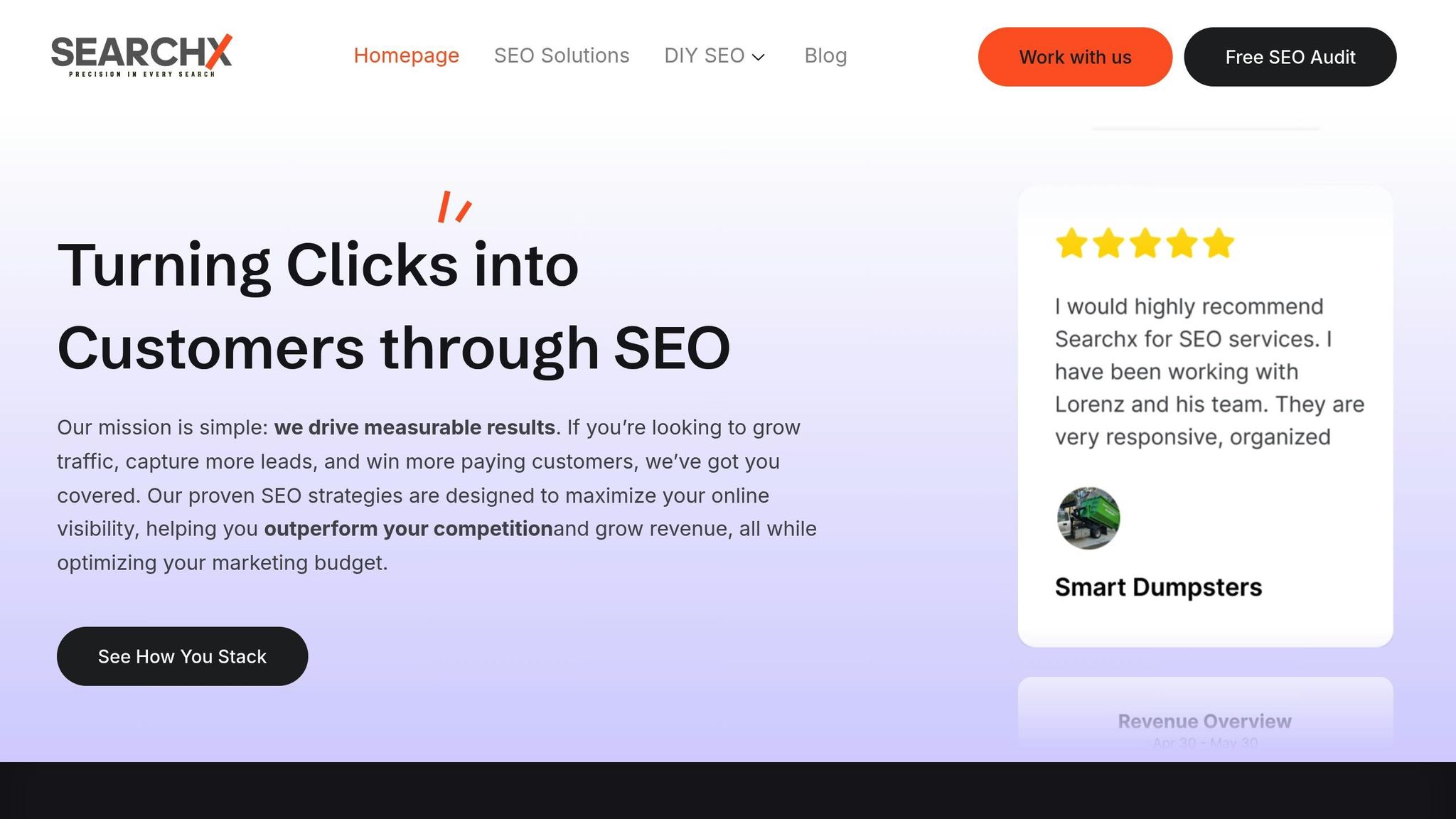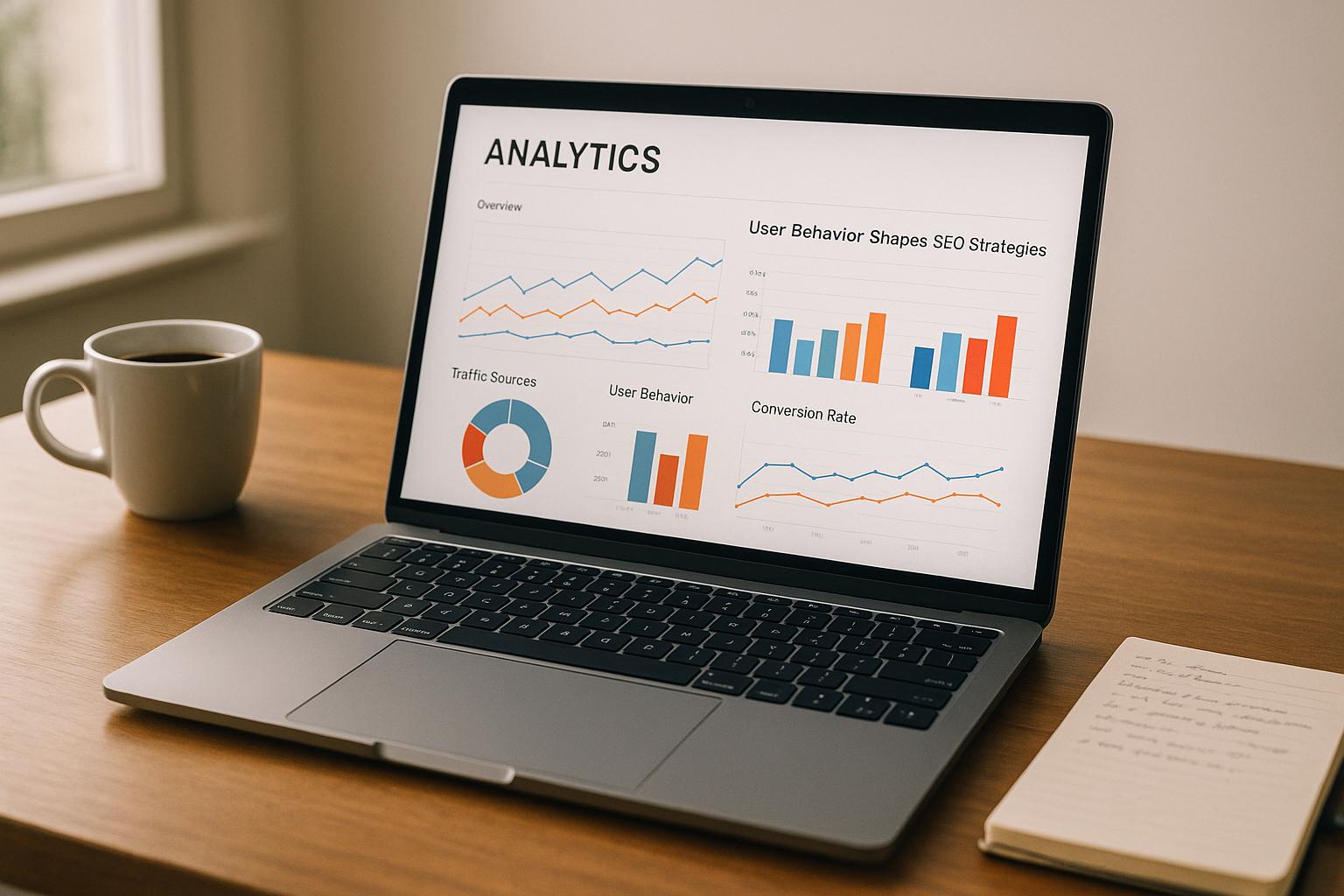User behavior plays a key role in how search engines rank websites. Metrics like click-through rate (CTR), bounce rate, dwell time, and conversion rate provide search engines with signals about how useful and relevant your content is. Websites that meet user expectations and engage visitors are more likely to rank higher.
Here’s the bottom line:
- CTR: Higher CTR indicates your content is appealing and relevant.
- Bounce Rate: A high bounce rate might signal that your content isn’t meeting user needs.
- Dwell Time: Longer time spent on a page shows your content is engaging.
- Page Speed: Slow pages can reduce conversion rates and hurt rankings.
- Search Intent: Aligning content with what users are looking for (informational, navigational, commercial, or transactional) improves performance.
User Behavior Analysis for SEO Strategy Excellence
Key User Behavior Metrics That Impact SEO
Search engines pay close attention to how users interact with your website. These interactions, often referred to as behavioral signals, play a key role in determining whether your content deserves a higher ranking or needs improvement. Below, we break down the most important user behavior metrics that can influence your SEO performance.
Click-Through Rate (CTR)
Click-through rate (CTR) measures how often users click on your search result after seeing it on the search engine results page (SERP). It’s a critical ranking factor because it reflects how relevant and appealing your content is to users.
Here are some key stats to consider:
- The top result on Google’s organic search results has an average CTR of 27.6%.
- Moving from the second position to the top spot can result in 74.5% more clicks.
- Pages in the #1 spot are 10 times more likely to get clicked compared to those in the #10 position.
- On average, moving up just one spot increases CTR by 2.8%.
- The top three results collectively capture 54.4% of all clicks.
Optimizing your page titles and URLs can make a big difference. Titles between 40 and 60 characters tend to perform best, and those with a positive tone can boost CTR by about 4%. URLs that include terms closely related to the target keyword see a 45% higher CTR compared to those that don’t.
For most businesses, a CTR above 3% is considered strong for SEO. The median CTR across industries is 1.99%, with nearly half of businesses reporting CTRs between 3–5%.
"The bottom line: click-through rate matters for organic rankings. If you bear the expected CTR, you’re in a good place. If you’re not, then expect rankings to fall." – Larry Kim
Next, let’s look at bounce rate and dwell time, two other metrics that reveal how users engage with your content.
Bounce Rate and Dwell Time
Bounce rate shows the percentage of visitors who leave your site after viewing just one page. It varies depending on the type of site: blogs often see bounce rates of 70–90%, content sites average 40–60%, and service sites typically range from 10–30%.
"The bounce rate is an important statistic that reflects the percentage of visitors who come to your website and leave or ‘bounce,’ typically by clicking the ‘back button’ to return to their previous search results or by closing the browser window entirely."
Dwell time, on the other hand, measures how long someone stays on a page before returning to the SERP. It’s a clear signal of how engaging and relevant your content is.
"Dwell time in SEO refers to the duration a visitor spends on a webpage before returning to the search engine results page (SERP). It indicates user engagement and content relevance, impacting rankings as longer dwell times suggest the content effectively meets the user’s search intent."
High bounce rates can hurt your SEO if they suggest your content isn’t meeting user expectations, while longer dwell times indicate your content is valuable and engaging. One red flag to watch out for is pogo-sticking – when users quickly return to the SERP after clicking on a link – which signals dissatisfaction and can negatively impact rankings.
Google’s RankBrain uses machine learning to evaluate these behaviors, factoring in metrics like organic CTR, bounce rate, and pogo-sticking to assess content quality. The good news? Simple changes can improve these metrics. For example, the Wistia blog increased dwell time by 260% just by adding a video to their content.
Now, let’s explore how time on page and conversion rates reflect content performance.
Time on Page and Conversion Rates
Time on page is another strong indicator of how well your content resonates with visitors. It’s closely tied to business outcomes, especially when paired with fast page load times.
Here’s why page speed matters:
- Faster-loading pages are 34% more likely to convert than slower ones.
- For every additional second of load time between 0 and 5 seconds, conversion rates drop by an average of 4.42%.
- A 1-second delay in page load time can reduce conversion rates by 7%.
Real-world examples demonstrate the impact of speed on conversions:
- Walmart increased conversions by 2% for every second they improved load time.
- Amazon found that a 100ms delay could cost them 1% in sales.
- Mobify reported a 1.11% boost in conversions for every 100ms improvement in their homepage load time.
Mobile performance is just as critical. Around 53% of mobile users will abandon a page if it takes longer than 3 seconds to load, and a 2-second delay can increase bounce rates by 103%.
To put things into perspective:
| Page Load Time | Conversion Rate |
|---|---|
| 2.4 seconds | 1.9% |
| 5.7 seconds | 0.6% |
Even small improvements can make a big difference. For instance, COOK, an e-commerce business, boosted conversions by 7% after reducing their page load time by just 0.85 seconds.
These metrics also highlight the importance of engaging content. With 73% of readers skimming posts instead of reading them thoroughly, it’s vital to grab attention quickly and keep users engaged.
Together, these behavioral metrics paint a detailed picture of user satisfaction. When users click, engage, and spend meaningful time on your site, search engines interpret these actions as signs of quality and relevance – rewarding you with better rankings.
Search Intent: Matching Content with User Needs
Understanding search intent is like holding a map to your audience’s needs. It’s not just about keywords – it’s about knowing the “why” behind a search. Whether someone is looking for information, a specific website, product comparisons, or ready to make a purchase, search intent shapes how you should craft your content. Nailing this alignment can improve rankings, increase engagement, and drive conversions.
"Search intent is the foundation of SEO and content marketing best practices because Google’s algorithm aims to match users with the most relevant results." – Siege Media
Google processes an astonishing 8.5 billion searches daily, and its algorithm is laser-focused on matching those searches to user intent. To keep up, your content strategy has to go beyond surface-level keywords and dive into the motivations behind each query. Let’s explore the four key types of search intent and how they can guide your content strategy.
4 Types of Search Intent
Every search query fits into one of four main categories, each requiring a unique content approach. Understanding these categories ensures your content meets users’ expectations.
Informational Intent dominates, making up about 52% of all Google searches. People with this intent are looking for knowledge or answers to their questions. For example, they might search for "how to improve website speed" or "what is search engine optimization." These users are in the research phase, so they need educational content like blog posts, guides, tutorials, or how-to articles.
Navigational Intent accounts for roughly one-third of Google searches. These users already know where they want to go; they’re just using Google as a shortcut. For instance, someone searching "Facebook login" or "Amazon customer service" has a specific destination in mind. To capture this audience, focus on having a strong brand presence and well-optimized homepages or landing pages.
Commercial Investigation Intent represents about 14.5% of searches. These users are weighing their options before making a decision. Queries like "best project management software 2025" or "iPhone vs Samsung comparison" fall under this category. Content like product comparisons, reviews, and buying guides can help users evaluate their choices.
Transactional Intent is the smallest but often the most valuable, making up less than 1% of all searches. These users are ready to take action, whether it’s purchasing a product, signing up for a service, or downloading something. Searches like "buy Nike running shoes" or "subscribe to Netflix" signal high intent, so optimized product or service pages are key to capturing these conversions.
| Search Intent Type | Percentage of Searches | Example Query | Best Content Type |
|---|---|---|---|
| Informational | 52% | "How to improve website speed" | Blog posts, guides, tutorials |
| Navigational | ~33% | "Facebook login" | Homepage, specific landing pages |
| Commercial Investigation | 14.5% | "Best project management software 2025" | Reviews, comparisons, buying guides |
| Transactional | <1% | "Buy Nike running shoes" | Product pages, service pages |
By understanding the difference between commercial investigation and transactional intent, you can tailor your content to meet users exactly where they are in their decision-making process.
How to Optimize Content for Search Intent
Creating content that aligns with search intent isn’t guesswork – it’s a deliberate process that combines data analysis with strategic planning. Here’s how to get started:
Analyze the SERP for your target keywords. Google’s search results are a goldmine of insights into user intent. For example, if you search "best running shoes" and mostly see comparison articles and buying guides, users likely have commercial investigation intent. If the results are filled with product pages and shopping ads, the intent is transactional.
Check out Google’s "People Also Asked" and "People Also Search For" sections. These features can reveal related queries and offer clues about what users are looking for.
"Understanding what and why someone is searching and aligning your brand, content, and engagement opportunities with it is central to SEO." – Corey Morris, Owner and President/CEO of Voltage
Pay attention to the language of search queries. Words like "how", "what", and "why" indicate informational intent, while terms like "buy" or "subscribe" point to transactional intent. Brand names or specific websites often signal navigational intent.
Use the "three Cs of search intent" to guide content creation:
- Content type: Decide on the format – blog post, product page, or landing page.
- Content format: Structure your content as a listicle, how-to guide, or comparison chart.
- Content angle: Develop a unique perspective or approach to the topic.
A great example of intent optimization comes from Backlinko. In 2024, they rewrote a post about SEO strategy that was stuck on page two of search results. By adjusting the content to better match user intent, the post earned a Featured Snippet position – without adding new backlinks.
Optimize meta titles and descriptions to reflect search intent. For informational searches, use titles like "How to…" or "Complete Guide to…". For commercial intent, try "Best…" or "Top 10…". For transactional queries, include action-oriented language and clear value propositions.
Finally, map your content to the buyer’s journey. Awareness-stage content should educate and provide broad insights. Consideration-stage content should compare options and offer detailed evaluations. Decision-stage content needs to focus on conversions by addressing final concerns and simplifying the path to action.
Experiment with different content formats to see what resonates most with your audience. Some topics might work better as videos, while others need in-depth written guides. FAQs can address informational intent, while product demos can cater to transactional intent. The key is to test, measure, and refine your approach based on what drives the best results.
Using User Behavior Data in SEO Strategies
User behavior data can be a game-changer for improving SEO efforts. By focusing on actionable insights, rather than drowning in excessive metrics, you can make meaningful adjustments that directly impact your search performance. The key is to streamline how you collect, analyze, and apply this data.
Collecting and Analyzing Behavioral Data
Before diving into data collection, it’s essential to define your goals. Are you aiming to improve rankings, increase engagement, or drive more conversions? Clear objectives will help you zero in on the metrics that matter most.
Google Analytics is a go-to tool for tracking key engagement stats like click-through rates (CTR), session duration, and user navigation paths. Pay close attention to high-traffic pages with low engagement – these often signal content that’s falling short of user expectations.
For search-specific insights, Google Search Console is invaluable. By monitoring CTR and impressions for specific queries, you can spot opportunities to tweak meta tags and descriptions for better performance.
Heatmap tools like Hotjar offer a visual representation of user activity, showing where visitors click, scroll, and linger. These insights can uncover areas of confusion, such as users clicking on non-interactive elements or overlooking key calls-to-action.
Combining data from multiple sources leads to deeper insights. For example:
- Segmentation: Break data into groups based on demographics or traffic sources.
- Trend analysis: Spot seasonal patterns or shifts in behavior.
- Cohort analysis: Track how specific groups of users interact with your site over time.
- Funnel analysis: Map the customer journey from landing page to conversion.
Sometimes, high bounce rates aren’t necessarily bad – users might be finding what they need quickly and leaving satisfied. Understanding these nuances allows for smarter adjustments.
Applying Data Insights to SEO Tactics
Once you’ve gathered and analyzed the data, the next step is to turn those insights into action. Start by testing different elements like headlines, calls-to-action, and content layouts through A/B testing to see what resonates most with your audience.
For instance, one e-commerce retailer used behavior data to dynamically adjust product descriptions based on search patterns and engagement metrics. This led to a 37% boost in organic conversion rates and a 22% rise in average order value. Behavior-driven strategies deliver results.
Content optimization should also be a priority. If users consistently leave a page quickly, it’s worth revisiting whether the content aligns with their search intent. High-traffic pages with low engagement can benefit from better keyword alignment, improved multimedia, and technical fixes.
Here’s a real-world example: A home building company struggled with low conversion rates despite moderate traffic. An analysis revealed that oversized hero images were pushing critical content below the fold. By resizing the images, reorganizing the layout, and adding strategic call-to-action banners, they saw a 122% increase in form submissions and phone inquiries.
Mobile optimization is another critical area. If data shows high mobile bounce rates or short session durations, it’s time to focus on faster load times and intuitive navigation for mobile users.
Page speed is equally important. Slow-loading pages drive users away, and even small improvements can make a big difference. Research suggests that moving up just one spot in search rankings can increase CTR by nearly 3%.
Monitoring and Improving Performance
SEO isn’t a one-and-done effort – it requires consistent monitoring. Tools like Google Analytics allow you to set up automated alerts for sudden changes in metrics like bounce rate, session duration, or conversion rates.
Monthly reviews can help you track seasonal trends, assess the impact of content updates, or evaluate technical changes. Annual deep-dive reviews provide a broader perspective on your site’s overall performance.
Session recordings and heatmaps are also invaluable for spotting new user behavior trends and evaluating recent site changes. As user needs evolve, your strategy should adapt to stay relevant.
Striking the right balance is crucial. While climbing the search rankings is important, maintaining strong user engagement and conversion rates is equally vital. Consider this: the top 5 search results capture about 67.6% of all clicks, while results ranked 6–10 only account for 3.73%.
Ultimately, user behavior data should guide your strategy – not replace the need for quality content. By leveraging these insights, you can achieve continuous improvements that enhance both your search performance and user satisfaction.
sbb-itb-880d5b6
Case Study: How SearchX Uses Behavioral Insights

SearchX takes a unique approach to SEO by leveraging user behavior data to craft strategies tailored to each client. Instead of relying on generic methods, they analyze how users interact with websites and search for information, using those insights to build campaigns that align with real-world behavior.
Custom Strategies Based on User Engagement
The process starts with AI-powered tools that provide real-time insights into user activity. SearchX monitors key metrics like click-through rates, session duration, and conversion paths, using this data to create strategies that address each client’s specific goals.
"AI delivers speed and scalability – yet, our core focus remains on understanding client needs and helping them reach the right audience." – Lorenz Esposito, CEO of SearchX
Their data dashboards make it easy to pinpoint actionable trends. For example, when working with local businesses, they map visitor navigation to identify where users drop off and where engagement opportunities lie. This allows them to refine keyword research and align it with actual search behaviors, rather than relying on assumptions.
SearchX also prioritizes education, offering resources and training to help clients understand how algorithm changes and shifting user behaviors impact their SEO. By working collaboratively, they ensure strategies stay effective as trends evolve.
These personalized methods have delivered measurable results, as seen in the following examples.
Real Examples of Behavioral Data Applications
SearchX’s data-driven strategies have led to tangible success for clients like Just Beachy Carts, a golf cart rental company in Isle of Palms. In early 2024, they analyzed search patterns for vacation rental services and noticed that users were combining location-specific terms with queries about immediate availability.
Using these insights, SearchX revamped the company’s content strategy and local SEO approach. Within just a few months, Just Beachy Carts climbed into the top three search results for "Isle of Palms Golf Cart Rentals", significantly boosting direct bookings.
"Before working with SearchX, our business was largely dependent on word-of-mouth. Now we’re regularly booked in advance thanks to increased online visibility." – Company representative, Just Beachy Carts
Another success story involves CHEERS Event Rentals in Charleston. Competing against national brands was a challenge, but SearchX discovered that local customers valued detailed service descriptions and quick contact options. By refining keyword strategies and improving the site’s structure, CHEERS secured top rankings for terms like "Event Rentals Charleston, SC".
"We knew our services were strong, but we needed better visibility online. SearchX gave us that edge." – CHEERS spokesperson
These examples highlight how SearchX uses behavioral insights to refine technical SEO services and content strategies, ensuring they meet user needs and search habits.
SearchX Tools and Resources
To maintain these results, SearchX equips clients with tools that integrate behavioral data into their SEO plans. These include AI-powered keyword mapping updates, personalized content recommendations, and performance tracking tools that adjust to evolving user patterns.
Additionally, SearchX offers free consultations to help businesses understand how behavioral data applies to their industry. Their educational materials cover everything from algorithm updates to user behavior trends, keeping clients informed and competitive.
"Our clients in Miami have different needs than those in Stockholm or New York. That’s why having teams on the ground matters – we’re not offering a one-size-fits-all approach." – Lorenz Esposito, CEO of SearchX
With teams in multiple regions, SearchX tailors strategies to fit local user behaviors. This localized expertise ensures that campaigns resonate with specific audiences.
SearchX’s focus on long-term growth means their tools and strategies are designed for sustained success. By continuously monitoring user trends and algorithm changes, they help clients maintain strong search performance over time.
"The goal is long-term success, not just short-term gains. That’s what digital growth strategy really means – building something that lasts." – Lorenz Esposito, CEO of SearchX
Conclusion: Improving SEO with User Behavior Data
User behavior plays a central role in shaping effective SEO strategies. With 93% of online experiences starting with a search engine, understanding how users interact with your website and content is no longer optional – it’s essential.
Consider this: a major e-commerce retailer revamped its product descriptions based on search trends and engagement data. The result? A 37% boost in organic conversion rates and a 22% increase in average order value from organic traffic. Clearly, using user behavior data isn’t just about climbing search rankings – it’s about achieving measurable business outcomes.
The secret lies in constant refinement. As Alba De La Oz from SEO Vendor puts it:
"Effective SEO isn’t a one-and-done deal; it requires continuous refinement and adaptation."
By leveraging tools like Google Analytics and Search Console, businesses can gather actionable insights, pinpoint user behaviors, and adjust strategies accordingly. This ongoing process ensures your content aligns with user intent, which is critical for standing out on the first page of search results. Why? Because less than 0.44% of users venture to the second page.
It’s also important to adapt to how users behave across different devices. Mobile users, for instance, tend to have shorter sessions and interact differently than desktop users. As Eric Schmidt, Google’s former CEO, aptly noted:
"We are moving from a mobile-first to an AI-first world."
This shift underscores the need for businesses to tailor their strategies to accommodate evolving user behaviors across all platforms.
The most successful SEO strategies focus on long-term growth, not quick wins. This involves creating content tailored to specific user personas, optimizing for mobile experiences, and ensuring transparency in data collection practices that respect user privacy.
At the heart of it all, SEO success hinges on prioritizing the user. Shivam M. from BRANDzUS explains it best:
"By making user behavior the central pillar of your SEO strategy, you’ll be well-positioned to adapt to whatever changes search engines implement, as ultimately, both you and the search engines share the same goal: providing the best possible experience for users."
Businesses that excel will be those that treat user behavior data as an ongoing feedback loop – fueling every aspect of their SEO strategy and driving sustainable growth.
FAQs
How can businesses use user behavior insights to refine their SEO strategies?
Businesses can dive into user behavior metrics such as click-through rates (CTR), bounce rates, and time spent on pages to fine-tune their SEO strategies. These data points reveal what content connects with users, helping you make adjustments that drive better engagement and improve search rankings.
Paying attention to search intent and tracking trends like social sharing or navigation patterns can make your content more relevant and user-friendly. This approach not only enhances the overall experience for visitors but also signals search engines that your site offers value, increasing its visibility in search results.
How does understanding search intent improve SEO content strategy?
Understanding search intent is crucial for crafting content that resonates with what users are looking for and aligns with their goals. When you design content to match specific query types – whether users are seeking information, navigating to a specific site, or making a purchase – you can boost relevance and attract the right audience.
By doing this, search engines are more likely to view your content as helpful, which can lead to better rankings and stronger engagement. Prioritizing search intent not only enhances the user experience but also delivers tangible SEO benefits.
Why is mobile optimization crucial for improving SEO performance based on user behavior?
Why Mobile Optimization Matters for SEO
Mobile optimization plays a big role in how users experience your website. With most online traffic now coming from smartphones and tablets, making your site mobile-friendly is no longer optional – it’s essential. A mobile-optimized site improves user experience, keeps visitors on your page longer, and lowers bounce rates. Plus, search engines give preference to mobile-friendly sites, which can boost your rankings.
When you optimize for mobile, you’re not just improving usability – you’re aligning with how people browse today. This makes your site more accessible and can lead to higher conversions. If you want your SEO strategy to truly connect with users and match their expectations, mobile optimization has to be a priority.




